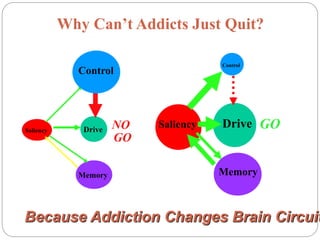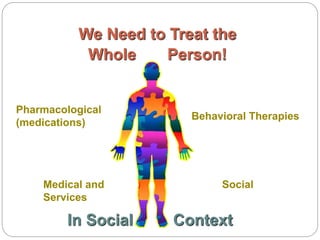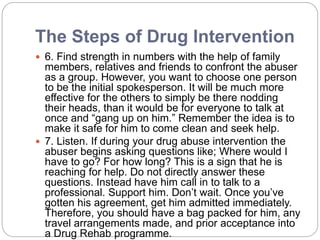Drug intervention.pptx
- 2. Presented By: Sidra Akhtar Drug Intervention
- 3. Drug Interventions A drug intervention is a structured, solution- oriented process undertaken to persuade someone who is abusing drugs to seek help in overcoming the addiction The goal of drug intervention is for the addict to accept the reality of their drug addiction and to seek help.
- 4. symptoms: Unpredictability while under the influence Spending a great deal of time thinking about using and/or actually using Attempting to quit with little success Frequent, unexplainable mood swings Becoming unreliable and untrustworthy Having difficulty focusing on projects or tasks Isolating oneself from others
- 5. 1 10 100 Child Teen Young Adult Adult 1.5% 67% 5.5% <12 12-17 18-25 >25 Addiction is a Developmental Disease: It Starts Early 26%
- 7. COMORBIDITY Drug Users have a Higher Risk of Developing Mental Disorders •Psychosis •Depression •Anxiety •Panic attacks Example: SMOKING EPIDEMIOLOGY normal population: 23% alcoholism: 90%+ other addictions: 90%+ schizophrenia: 85% depression: 80%
- 8. Is a Drug Intervention Necessary? Some drug addicts can and do recognize the extent of the problems stemming from drug abuse and seek treatment without the need for an intervention. They may instead blame other people or circumstances in their lives They ignore the safety issues related to drinking and driving and other high-risk behaviors. It is common for addicts to deny that drugs are the source of the difficulties they face.
- 9. Interventions Prepare letters describing the effects of the addict’s behaviors on their lives Develop boundaries and learn how to uphold them to prevent enabling behaviors Create a list of behaviors commonly frequented by the addict that the family will no longer tolerate
- 10. Why do Mental Illnesses and Substance Abuse Co-occur? Self-medication hypothesis substance abuse begins as a means to alleviate symptoms of mental illness Causal effects of substance abuse Substance abuse may increase vulnerability to mental illness Common or correlated causes the life processes and risk factors that give rise to mental illness and substance abuse
- 11. Source: Adapted from Volkow et al., Neuropharmacology, 2004. Drive Saliency Memory Control Non-Addicted Brain NO GO Addicted Brain Drive Memory Control GO Saliency Why Can’t Addicts Just Quit? Because Addiction Changes Brain Circuit
- 12. Pharmacological (medications) We Need to Treat the Whole Person! In Social Context Behavioral Therapies Medical and Social Services
- 14. But, drug addiction is a chronic illness with relapse rates similar to those of hypertension, diabetes, and asthma
- 15. Addiction is Similar to Other Chronic Illnesses Because: Recovery from it--protracted abstinence and restored functioning-- is often a long-term process requiring repeated treatments Relapses to drug abuse can occur during or after successful treatment episodes Participation in self-help support programs during and following treatment can be helpful in sustaining long-term recovery Therefore…
- 16. Full recovery is a challenge but it is possible …
- 17. We Need to Keep Our Eye on the Real Target In Treating Addiction…
- 18. Why focus on drug abuse internationally? I. Drug abuse is a global phenomenon 5 percent of people aged 15-64 II. Intertwined dual-epidemics of drug addiction & HIV/AIDS HIV Infections Attributed to Injection Drug Use and Risky Sexual Behaviors Related to Drug Abuse Millions of Users 160.9 26.2 13.7 15.9 7.9 Cannabis Amphetamines Ecstasy Cocaine Opiates UNODC 2005 World Drug Report III. Take advantage of unique opportunities to advance scientific knowledge through research
- 19. Where Do We Need to Go From Here? We Need to… Advance the SCIENCE Erase the STIGMA and to… Erase the STIGMA and to…
- 20. The Steps of Drug Intervention 1. Stop all “rescue missions.” Family members often try to protect an abuser from the results of their behaviour by making excuses to others about their abuse problem and by getting them out of drug- related jams. It is important to stop all such rescue attempts immediately, so that the addict will fully experience the harmful effects of his use and thereby become more motivated to stop. 2. Don’t enable them. Sometimes family members feel sorry for the addict or tend to avoid the abuser; let them come and go as they please. This comes across to the abuser as a reward—after all, all he wants is to be left alone. 3. Time your drug abuse intervention. If possible, plan to talk with the addict when he is straight. Choose a time when all of you are in a calm frame of mind and
- 21. The Steps of Drug Intervention 4. Be specific. Tell the family member that you are concerned about his drug or alcohol abuse and want to be supportive in getting help. Back up your concern with examples of the ways in which their drug abuse has caused problems for you, including any recent incidents. 5. State the consequences. Tell the family member that until he gets help, you will carry out consequences—not to punish the drug abuser, but to protect yourself from the harmful effects of the abuse. These may range from refusing to be with the person when they are under the influence, to having them move out of the house.
- 22. The Steps of Drug Intervention 6. Find strength in numbers with the help of family members, relatives and friends to confront the abuser as a group. However, you want to choose one person to be the initial spokesperson. It will be much more effective for the others to simply be there nodding their heads, than it would be for everyone to talk at once and “gang up on him.” Remember the idea is to make it safe for him to come clean and seek help. 7. Listen. If during your drug abuse intervention the abuser begins asking questions like; Where would I have to go? For how long? This is a sign that he is reaching for help. Do not directly answer these questions. Instead have him call in to talk to a professional. Support him. Don’t wait. Once you’ve gotten his agreement, get him admitted immediately. Therefore, you should have a bag packed for him, any travel arrangements made, and prior acceptance into a Drug Rehab programme.























